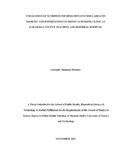| dc.description.abstract | The primary role of food labels is to inform consumers on the composition of food, ingredients and their relative amounts. Diabetes mellitus and hypertension are key public health problems due to lifestyle changes that encompass diet and food choices. Nutrition information conveyed on food labels is important in informing the consumer of the suitability of the food being purchased for their needs and health conditions. However, utilization of this information depends on their understanding of the importance and use of the information. Current global mortality rate from diabetes mellitus and hypertension remains unacceptably high. A major reduction diabetes mellitus and hypertension should come from population-wide interventions including the promotion of a healthy diet through the provision of adequate and appropriate nutrition information on food labels. The main objective of the study was to assess utilization of nutritional information on Food Labels by diabetic mellitus and hypertensive patients and Specific objectives were; to determine the relationship between socio-demographic characteristics and utilization of food labels, to establish factors influencing utilization of Nutrition Information on food labels and to determine whether patients with diabetes mellitus and hypertension utilize food labels. A total of 125 patients were included in the study. The study adopted cross-sectional design with qualitative methods for data collection, analysis and presentation. Systematic random sampling was used to select the study participants. A total of 125 questionnaires were administered and the response rate was 80%. Data was analyzed using SPSS version 25 and presented in the form of graphs, charts and tables. Statistical significance was set at p<0.05. The study assessed the socio-demographic characteristics of the respondents such as gender, age, level of education, marital status, occupation and income levels. Among the sociodemographic gender (p= 0.634), Marital status (p=0.077) and Religion (p=0.931) did not influence reading of nutrition information on food labels. However, Age (p= 0.028), Education (p= 0.001), Job/employment (p=0.0010), Monthly income (p=0.001) and Monthly household food expenditure (p=0.007) did influence utilization of nutrition information on food labels. Majority 64% (n=64) of the participants reported to be knowing what food labels are and only 34% (n=34) reported of not knowing what they are. About 46.8% (n=30) of the participants reported that they read nutrition information every time they purchased the product, 37.5% (n=24) read the information the first time they purchased the product and 15.7% (n=10) reported that they read nutrition information on food labels at other different times. This study also found out that nutrition information on food labels were utilized based on key nutrients and carbohydrate most utilized and dietary fiber least utilized nutrients. Food prices, nutrition information on the food label, health and nutrition status and fat/sodium/sugar content were among the factor that had a high influence on utilization of food labels. From the findings of this study there is need to educate general population on benefits of reading nutrition information on food labels in order to make healthful food choices | en_US |

